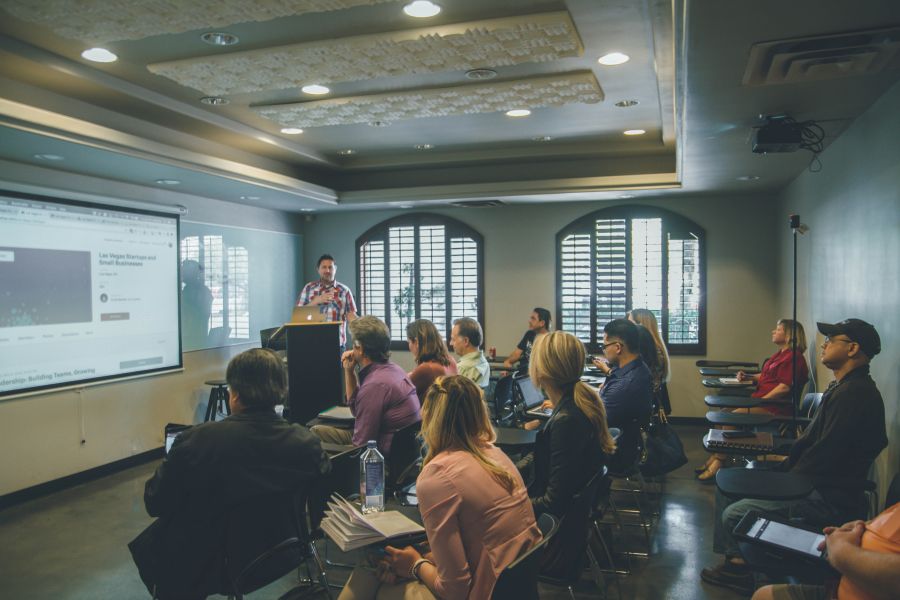职业高中英语教案高一2021范文1
Teaching aims and demands:
a. Achieve language skills and related knowledge about the topic of friends and friendship;
b. Learn to express likes and dislikes and make apologies:
c. Vocabulary in this unit:
the words and expressions listed on the teacher’s book
d. Grammar:
Direct and indirect speech
Lesson 1
Step 1 Presentation and discussion (warm-up)
Put some new words on the blackboard and tell them something about a friend.
Kind honest brave loyal happy wise strong
beautiful handsome rich smart funny
Then ask some questions around the class and discuss with them.
What should a good friend be like?
What qualities should a good friend have?
Should they be funny, smart and strong?
Step 2 Reading
Ask the students to read the dialogue in the part SPEAKING. Ask some questions:
1.What doesn’t John like?
2.What does Joe think of music and skiing?
And then fill in the form on page 3.
Then ask the students to express their ideas freely. Encourage the students to say more about friends.
Step 3
Listening
Ask the students to listen to the tape and fill in the blanks in the listening part.
Step 4 Talking/Practice
Ask the students to page 85. Make a similar dialogue as in exercise 2.
Some useful expressions :
Why did you…? Why didn’t you…? You said that you would…
Please forgive me. You promised to … I’m very sorry… It won’t happen again. I forgot.
Step 5 Homework
Finish Exercise 3 in the workbook.
Lesson2
Step1 Revision
Ask several students to present a speech about friends as a revision.
Step 2 Pre-reading
Present the students a picture to illustrate the situation on a lonely island. Ask them to list three items in the box and ask them to give the reasons using the sentences listed on page3.
Step 3 Reading
Before asking the students to read the text, first give the students a brief introduction about Tom Hanks, his films and the film Cast Away.
Then students read the text, and answer the following questions.
1.How does Chuck Noland come to a deserted island?
2. In order to survive on the island alone, what does he need to learn?
3. What does he understand at last?
4. For us, what lesson we can learn from Chuck?
At the same time explain the language points if necessary.
Step 4 Post-reading
Discuss the following questions in the Part POST-READING.
Step 5 Homework
Prepare a talk about Tom Hanks or something about one of his film.
Lesson3
Step 1 Revision
Get the students to give a talk about Tom Hanks or something about one of his films.
Step 2 Language Study
Ask the students fill in the blanks with proper words.
Step 3 Grammar
Illustrate to the students the use of Direct and Indirect Speech.
Then ask the students to do the exercise in the Part Grammar on P5.
Step 4 Practice
Ask the students to act the exercise2 in the part Grammar out.
Step 5 Homework
Ask the students to finish the exercise2 in their workbook.
Lesson4
Step 1 Revision
Check the homework.
Step 2 Presentation
Present simples of e-mail to get the students a general idea of e-mail.
Step 3 Explanation
Tell the students some tips of writing an e-mail by learn the above e-mail simple.
Step 4 Writing
Ask the students to write an e-mail message.
Step 5 Homework
Ask the students to try to write an e-mail to their e-pal.
职业高中英语教案高一2021范文2
Teaching Aims and Demands
Words and Phrases
Four Skills: stomach fever ought ought to examine plenty plenty of diet keep up with make a right choice short of fit gain now and then
Three Skills: energy soft bar fuel chemical balance tasty boil mixture
Spoken English:
In the clinic / seeing a doctor:
What’s wrong with you?/What’s the matter with you?
Lie down and let me examine you.
Let me have a look.
Where does it hurt?
Drink plenty of water and get some rest.
I’ve got a pain here. This place hurts.
There’s something wrong with back/my knee/my arm.
I don’t feel well.
Grammar:
Use of Language:
1. Master the function use of language as defined above.
2. Help the students to finish the tasks of listening, reading, writing, speaking presented in the book and the exercise book through using what the students have learned.
Learn the text about healthy eating. Get the students know about the basic knowledge of how to eat healthily.
Important points:
1. Talk about different kinds of food that one favorites.
2. learn the basic knowledge of healthy eating.
3. learn how to say in the clinic.
4. Grasp the language points and grammar in the text.
Difficult points: The use of modal verbs --- had better, should and ought to.
Teaching aids: computer or slider-projector
Way of Teaching: Communication way of teaching, discussion and group work.
Lesson 1Step 1 Warming-Up
First show the students some pictures of dishes and so to introduce the topic of this unit.
And then show the pictures on their text books and let them to decide what is junk food and what is not.
Here the students may have a short ask and answer in pairs to themselves more engaged in the topic.
Step 2 Listening
Let the students listen to the tape and be prepared to answer the questions below.
Step 3 Speaking
Show the students the three situations as on P2. Then ask the students to prepared a dialogue according to the examples in pairs. Ask several pairs of students to present their dialogue
After that list the useful expressions in their dialogue.
Step 4 Homework
Prepare for the next class.
Collect some menus if possible for the next class.
Lesson 2
Step 1 Introduction
Using the questions on P3 to introduce the new text.
Step 2 Fast-reading
1.What does the “fuel ” mean in the first paragraph?
(It means different kinds of materials, such as protein, Calcium that we need to keep healthy.)
2.What do we have to consider when we choose to buy or eat?
(What kinds of nutrients that the food contain.)
3.What made our eating habit changing?
(Many things: what people believe, advice from companies and stores.)
4. How can we feel and look fine?
(We ought to learn about our body and the fuel it needs to keep fit.)
Explain the language points if necessary.
Step 3 Carefully-reading
How many parts can be divided into?
(Three parts.)
What’s the main idea of each part?
(1.our eating habits are changing. 2.why the eating habits are changing 3.the best way to develop healthy eating habits.)
Step 4 Talking
Ask the students to take out their menus and read them carefully. Then prepare a dialogue that may happen between a customer and a waiter/waitress.
Step 5 Homework
Finish the exercise --- Vocabulary on P5. and P72-73
Lesson 3
Step 1 Revision
Check the homework.
Step 2 Grammar
First present the students the modal sentences with Modal Verbs and ask the students to make some sentences with them.
Step 3 Consolidation
(1) Finish the exercise on P5 and on P74
(2)Take out a piece of paper with the column “Ask ###” in order to make the students understand when you are giving advice it is better to use some sentences with had better (not), and ought(not) to, should(not). Then read a passage as an example and afterwards list the points you have to pay attention to when you give advice.
1.give advice that will really help the person.
2. be polite and sincere
at last get the students to finish the following practice.
Step 4 Homework
Finish the exercise 3 on P74 in the students’ workbook.
Lesson 4
Step 1 Revision
Let some students read their reply to the letters on P74.
Step 2 Reading
Read the text on P6 and then get the students to find the main idea of it (Snacks is also important . we need to learn something about snacks and the way to prepare it.)
Step 3 Writing
Ask the students to work in pairs to write the recipe for their favourite dish.
We may first give the tips on P7 as a guide.
Step 4 Discussion
First ask the students to read the passage on P75 and then give the following questions as the topic for the students to talk: What is a couch potato?
What does one have to pay special attention to in order to keep healthy? (food and exercise etc.)
Step 5 Homework
Do a general survey in order to learn about the differences between people’s eating habits and try to find which is healthier.
职业高中英语教案高一2021范文3
Ⅰ. Teaching Basis (教学依据) :《普通高中英语新课程标准》
Ⅱ. The Type of the Text (课型) :Revision (复习课)
Ⅲ. Teaching Methods(教学方法): Question-based method(提问式),Group discussion
method(小组讨论法),Cooperative learning(合作探究),Practicing(练习).
Ⅳ. Teaching Aids (教学手段) :Multimedia computer(多媒体电脑),Learning
paper(导学案),Blackboard(黑板).
Ⅴ. Teaching Aims(教学目标) : ①Knowledge aims(知识目标):
words: achievement, specialist, organization, hard-working, confident….. phrases: put to death, mean doing, either…or…, the bond between……, structure: only+…., It is/was+….+that…. grammar: Subject-verb agreement.
②Ability aims(能力目标): Develop the students’ ability to use the important
language points, enable students to describe people using the adjectives.
③Emotional aims(情感目标): Encourage the students to think about what makes a
person great.
Ⅵ. Teaching focuses(教学重点):Get the students to review and consolidate what they
have learned in this unit.
Ⅶ. Teaching difficulties(教学难点):Get the students to turn what they have learned into
their ability.
Ⅷ.Teaching procedure(教学过程): Step 1 复习学案情况反馈(1分钟)
Step 2 lead-in :通过图片展示的方式,过渡到知识竞答类节目《一站到底》,本节课也将模仿这种模式授课。依次介绍本节课的竞答规则:
本此活动分为五轮淘汰赛,全班共八个小组,每个小组推荐一名选手(作为本组站神)进行参与:
→→第一轮采用记单词的方式,进行车轮大赛,最终淘汰掉一个小组,剩余七个小组成功晋级第二轮,成功晋级的小组将获得5分,加入到本组的总量化分数中;
例:
1. n.成就,功绩 _______________________ 7 .n. 巢,窝 ________________________
2. n.福利,福利事业 _________________ 8..n. 联系,关系,结合,纽带_________ 3. n,项目,工程,规划 _________________ 9. n. 观察,观测,遵守 ______________ 4. n.学会,学院,协会 _________________ 10. n. 童年,幼年时期 ________________
???.
→→第二轮节采用记短语的方式,在成功晋级的7个小组中进行车轮赛,最终淘汰掉两个小组,剩余5个小组成功晋级第三轮,成功晋级的小组将获得的分数为上一轮得分的二倍(即5_2=10); 例:
1.过着…的生活 ____________________ 6 .离开,启程,出发 ________________ 2.涌上心头,涌入脑海 ______________ 7.藐视,瞧不起 ___________________ 3.查阅,参考,谈到 _______________ 8. 碰巧,凑巧 ___________________ 4.偶然遇见,碰见 ________________ 9 继续,坚持 ____________________
???
→→第三轮采用背诵句子的方式,在成功晋级的5个小组中进行车轮赛,最终淘汰掉三个小组,剩余两个小组成功晋级第总决赛,并且这两个小组均获得一次免答权,这两个小组将获的分数为上一轮得分的二倍(即10_2=20); 例:
(1)她的一生全都奉献给了中国妇女和儿童的医疗事业。
She (2)这意味着我们要返回前一天晚上我们离开时黑猩猩一家睡觉的大树旁。;
back to the place we left the family sleeping in a tree (3)简预先提醒我们,到下午的时候我们就会又脏又累,她说对了。
(4)她母亲头几个月来帮过她的忙,这才使她得以开始自己的计划。
begin her project.
(5) 比方说,她的一个重要发现是黑猩猩猎食动物。
was that chimps hunt and eat meat. ???
→→第四轮为复活赛,在前三轮车轮赛中被淘汰的6个小组,均可获得一次复活机会,但是复活赛的要求非常苛刻,每个参赛的小组必须能够正确背出随机指定的3个句子,8个短语,10个单词,如能成功过关,将直接晋级总决赛,但不享有免答权;假如没有成功过关,所有分数将清零。 例:
(1)她的一生全都奉献给了中国妇女和儿童的医疗事业。
speakers.
A. go on B. carry on C. carry out D. work on
3. The new equipment ________ the disabled during the 2008 Beijing Paralympics. A. was intended for B. was intended to C. intended for D. intended to
4. He was an ________ poet at that time and his _____ poems spread through all the country. A. inspired;inspired B. inspiring;inspired C. inspired;inspiring D. inspiring;inspiring
She (2)这意味着我们要返回前一天晚上我们离开时黑猩猩一家睡觉的大树旁。;
???
注意事项:(1)小组加分不累计。
(2)前三轮车轮赛中,每次选手必须更换,从第四轮开始可自由安排,各
小组相互监督,如有违规取消其参赛资格及所得分数。
(3)每轮车轮赛中间设1-2分钟准备时间。 (4)参赛选手在准备时间内抽取答题顺序。
设计意图:(1)增加学习的趣味性,提高学生的参与度,提高课堂效率。 (2)培养团队协作能力,增强竞争意识。
(3)尝试一种新的模式,改变英语课堂的沉闷现状。 Step 3 Summing up (总结):
Step 4 Homework :(1)写作专题突破, 根据提示用英语写一篇介绍宋庆龄的短文。
(2)Review and summarize what you have learned in Unit 1. (3)Preview the next unit.
Step 5 Blackboard Design (板书设计):
back to the place left the family sleeping in a tree (3)简预先提醒我们,到下午的时候我们就会又脏又累,她说对了。
and she is right.
1.与某人联系______________________ 2.计算出,得出 _____________________ 3.大胆的说,直率的说______________ 4.迫不及待做某事____________________ 5.获得博士学位____________________ 6.为了某人 _________________________ 7.为什么不呢______________________ 8.大学入学考试(高考)______________ 1 .vt&vi. 举动,表现________________ 2 .vt. 观察,观察____________________ 3. vt&n. z尊敬,尊重,敬意_________ 4 . vt&vi.讨论,争辩,辩论___________ 5. vt.鼓舞,激发,启示_____________ 6 .vi.谈到,查阅,参考_______________ 7. vt,计划,打算 _________________ 8.vt 递送,生,接生,发表___________ 8.adj.直言的,坦诚的_______________ 10. adj.值得的,值得做的______________
……….
→→第五轮为总决赛,所有进入的总决赛的小组,将随机抽到一个单选题目,请在20秒的时间内给出答案,并进行解释说明,如果回答错误将直接被淘汰。直到剩余最后一个小组,最后的胜利者的小组将获得“站神”的称号,并将获得全场分40分。
职业高中英语教案高一2021范文4
(1)课题:Friendship
(2)教材分析与学生分析: 本单元的中心话题是“友谊”,几乎所有的内容都是围绕这一中心话题展开的。Warming Up部分以调查问卷的形式引导学生了解日常生活中朋友之间发生的真实问题以及解决这些问题的方法;Pre-Reading部分的几个问题启发学生对“友谊”和“朋友”进行思考,使学生明确不仅人与人之间可以做朋友,日记也可以成为人们的朋友;Reading部分Anne’s Best Friend以日记形式讲述了犹太女孩安妮的故事;Comprehending部分通过连句、多项选择和问答形式帮助学生对课文内容、细节进行更深入的理解; Using about Language 部分教学本课重点词汇和重点语法项目。
(3) 课时安排:The first period: Speaking: Warming Up and Pre-Reading The second period: Reading
The third period: Grammar
The forth Period:Listening
The fifth period: Writing
(4)教学目标:
①知识与技能:Talk about friends and friendship; Practise talking about agreement and disagreement, giving advice and making decisions; Use direct speech and indirect speech; Learn to write an essay to express and support an opinion.
②过程与方法:本单元在读前阶段就提出问题,让学生思考是不是只有人与人之间才能交朋友,然后在阅读中通过安妮的日记向学生说明我们也可以与动物及无生命的日记交朋友。在深刻理解、充分训练的基础上,可以再引导学生深入讨论几个与本单元话题有关的问题:1.描述朋友; 2. 结交网友;3. 观点交流;4. 善不善交朋友; 5. 朋友的重要性。
③情感态度与价值观:学完本单元后要求学生进行自我评价,主要评价自己在本单元中的学习情况。对书中的内容是否感兴趣,有哪些收获,解决了什么问题。使学生加深对友谊、友情的.理解,以及如何正确交友,处理朋友之间发生的问题等。
(5) 教学重点和难点:
词汇:add point upset ignore calm concern cheat share reason list series crazy nature purpose dare thunder entirely power according trust suffer advice situation communicate habit
短语: add up calm down have got to be concerned about go through hide away set down on purpose in order to face to face according to get along with fall in love join in
重点语法项目: 直接引语和间接引语的互相转换
难点:Understand the real meaning of friends and friendship;
Discuss the answers to the questions (Reading);
How to teach the Ss to master the usage of Direct Speech and Indirect
Speech(Statement and Questions).
(6) 教学策略: Discussion, Student-centered vocabulary, learning, listening, pairwork, teach grammar in real situation
(7) 教学煤体设计: A projector and a tape recorder.
(8) 教学过程:
Period One:Speaking (Warming Up and Pre-Reading)
Aims
Talk about friends and friendship.
Practise talking about agreement and disagreement.
Step I Revision
Ask some of the students to read his / her composition for the class, describing one of the problems between friends and how it is solved. Then give some comments.
T: Now, let's check up your homework for last class. I'd like some of you to read his / her composition for the class, describe one of the problems between friends and how it is solved.
Step II Warming up
T: / think most of us have some good friends. Do you know why people make friends with one another?
Step III Talking(WB P41)
First get the students to listen to what a Canadian say about making friends. Then ask them to discuss the two questions.
T: Now we're going to listen to what Leslie Clark, a Canadian has got to say about making friends. After listening, please talk about the two questions in groups of 4. Try to use the following expressions.
1 Do you agree with her?
2 What do you think of people from foreign countries?
Agreement Disagreement
I think so, I don't think so.
I agree.I don't agree
That's correct.Of course not.
That's exactly my opinion. I'm afraid not.
You're quite right. I don't think you are right.
Step IV Speaking(B P6)
First, get the students to think of four situations among friends in groups of 4 and design a questionnaire to find out what kind of friends their classmates are. Second, try it out on their own group, checking the questionnaire through and adding up their score and see how many points they can get. Ask them to fill in the form prepared before class. Show the instructions and decide what kind of friends their classmates are. Third, ask each student to stand up and walk around the classroom to make a survey on four of other classmates. Show the instructions and decide what kind of friends other classmates are. They can share your questionnaire with one or two other groups and try each other's questionnaires.
At last, show the instructions to help your classmates to know how to improve his or her skills of making good friends with others if necessary.
T: Friends come in many flavors. There are best friends, school friends, fair-weather friends, forever friends and many more. Do you want to know what kind of friends your classmates are? Now let's make a survey. First, please think of four situations among friends and design a questionnaire to find out what kind of friends your classmates are.
1. Your friend borrowed 100 Yuan from you last week and hasn't returned it. You will
A. ask him / her to pay back as soon as possible; or you'll end the friendship.
B. ask him / her to pay back if he / she has.
C. tell him / her not to return it.
2. Your friend said your bad words behind you. You will
A. ask him / her to say sorry to you , or you'll stop your friendship.
B. excuse him / her and forget it.
C. ask others to tell him / her that he/she is wrong.
3. You promised to meet your friend at five o'clock but your parents ask you to do homework at home. You will
A. tell him your parents ask you to do homework at home.
B. tell him / her a lie that you are ill.
C. say sorry to him / her and plan to meet him / her another time.
4. You borrowed a bike from your friend, but you had it stolen. You will
A. buy a new one which is the same as his / hers.
B. just tell him / her you had it stolen.
C. say sorry to him/her and buy him/her an old one
After they finish choosing the answers, show the scoring sheet on the screen.
Instructions:
2-5 A fair-weather friend
Only like them when they are happy and popular. If they are feeling down, or if they are having a problem, you don't want to spend time or talk with them. You don't help your friends when they have problems. You are always thinking about yourself.
You should care more about your friends. If you continue to be self-centered and don't consider others' feelings, you won't make more friends and keep friendship for long.
6-11 A school friend
You see each other in school. You just study and play with them together in school. You may not know everything about each other. You take things smoothly. You seldom hurt your friends with your benefit considered. You'd better add more affection to your friends. Friendship is about feelings and we must give as much as we take.
12-17 A best friend
You do everything together with your friends: study, read, watch TV, surf the Internet, play sports and listen to music. If either one has a problem, the other is there to help. You know your friends very well. You understand and yield to each other. You help with each other and improve together. You have a lot of common benefit. Your friendship is good to both of you. You are mutually beneficial.
18-21 Forever friend
You will always listen to your friends and try to help them, even if you disagree or if you are having a problem. Whenever they have any difficulty, you'll try your best to do what you can to help them without hesitation. You devote yourself to your best friends. You are willing to lose what you have, even your life.
课后反思:本课教学设计容量和密度较大,但难度适中,大部分学生都能接受。体现全面照顾大部分学生的教学理念。注意培养学生开口说英语的的信心。
职业高中英语教案高一2021范文5
1. Ability goals 能力目标
To help the Ss develop their reading ability by skimming for main ideas and car eful-reading for details with the teacher’s guidance.
To get The Ss to master some key words such as witness, abandon, yell, drag, flee and so on.
2. Learning ability goals 学能目标
To enable the Ss to talk about animals under the sea.
To help the Ss know the importance of the relationship between animals and humans.
教学重难点
教学重点和难点
Teaching important points 教学重点
Help the Ss know more about animals under the sea as well as the animals’ loyalty and help to human bein gs.
Teaching difficult points 教学难点
1. Help the Ss get the main idea and some detailed information by fast-reading and careful-reading.
2. Help the Ss tell apart from Before, During and After in the story.
教学过程
Step1. Warming Up : Talk about animals under the sea.
1. Have you ever seen some marine animals?
2. What have you seen, and where have you seen them?
I have seen a/some/many…… in/on/from……
amazing marine animals: seal, turtle, dolphin, sea-horse, sea-star, shark, angelfish, jellyfish, lobster, coral
Step2. Fast-reading:
1. Find out the Background Information of the story : writer, career, writing style, time, place, main character.
2. Find out the Main Idea of the passage: What’s the first story mainly about?
Step3. Careful-reading:
1. Clancy had heard of the killer whales that every year killer whales would help whalers catch baleen whales. Did he believe it at first? When did he believe it was a true anecdote?
2. How many paragraphs are there all together in story1? The hunt can be divided into 3 stages.
Stage1: before the hunt: (para. 2-6):
Old Tom’s doing: throwing itself out of … and crashing down again… Why? to tell the whalers…, …by the boat…, circling back to …Why? to lead the whalers…
Whalers’ reaction: Another whaler __________. George _____ ___ _____ Clancy, and Clancy ______ after him. They __________ the boat and ______ ____into the bay.
Stage2&3: Dur ing and after the hunt: (para. 7-9):
Killer whale’s doing: The killers over there are ________ themselves on the top of the whale’s blow-hole to stop it __________; and some others are stopping it _______ out to sea. The killers started ________ between our boat and the whale just like a pack of ____ ___ dogs. When the baleen whale was dead, its body wa s _______ down into the depths of the sea.
Whalers’ reaction: The man in the bow of the boat aimed the harpoon at the whale and then let it go to hit the spot.
Conclusion: They have amazing relationship. They work as a team
Step4 : Summary
Working at the _______station, I had the chance to _________ a baleen whale being attacked by a ______ of k iller whales.
On the afternoon I arrived at the station, as I was __________ my accommodation, I heard a loud noise coming from the bay. I ran down to the ______ in time to see an enormous animal _________ itself out of the water and then _______________ again. George told me it was Old Tom, who announced there would be a ___________.
Using a _________, we could see a baleen whale _______________ by about six killers. Some are ________ themselves on top of the whale’s __________to stop it breathing; and some others are stopping it _______ out to sea. The whalers aimed the ________ at the whale and then let it go to hit the spot. Being badly ________, the whale soon died. Very soon, its body was ________ by the killers down into the _______ of the sea.
课后习题
课后作业
Deal with Exercise 3 in Comprehending . Let the Ss work in groups and do some discussion:As a matter of fact, whales are now an endangered animal. Many people are trying to protect them from being hunted. The last whaling station in Australia closed in 1978. But some countries oppose the ban. An d there are still people who hunt whales. What’s your opinion? Are you for or against the banning whaling? Consider the problem carefully and we’ll have a discussion tomorrow.
推荐文章
河南高考排名195560左右排位理科可以上哪些大学,具体能上什么大学2024-06-08 12:22:13
吉林外国语大学和湘潭大学兴湘学院哪个好 附对比和区别排名2024-06-08 12:17:15
江西工商职业技术学院在黑龙江高考历年录戎数线(2024届参考)2024-06-08 12:13:44
甘肃高考排名5480左右排位理科可以上哪些大学,具体能上什么大学2024-06-08 12:10:50
四川文化艺术学院和天津城建大学哪个好 附对比和区别排名2024-06-08 12:07:58
江西高考排名71510左右排位理科可以上哪些大学,具体能上什么大学2024-06-08 12:05:17
初一下册英语优秀教学方案模板2023-08-10 07:10:31
英语听力技能提升的教学规范方法模板2023-08-23 17:41:14
高考英语听力学习方法整理2023-08-20 16:51:53
七年级英语单元教学设计范文2023-08-17 03:59:24
初一下册英语优秀教学方案模板2023-08-10 07:10:31
英语听力技能提升的教学规范方法模板2023-08-23 17:41:14
高考英语听力学习方法整理2023-08-20 16:51:53
新学期英语教学研修计划2023-08-13 11:59:23
小学三年级英语课程教案范文五篇2023-08-19 04:53:22
英语口语考试资料必备2023-08-18 01:55:49





